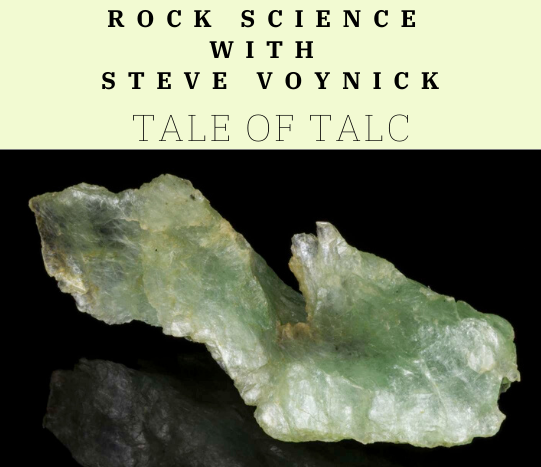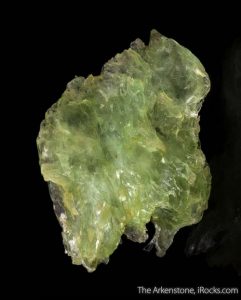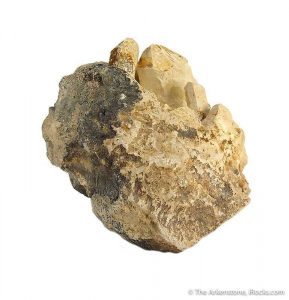
By Steve Voynick
Talc is well-known to mineral collectors for its hardness or, more precisely, its lack of hardness. Ranking 1.0 on the Mohs hardness scale, talc is the softest of the more than 5,400 recognized minerals.
Talc, or basic magnesium silicate, chemical formula Mg3Si4O10(OH)2, crystallizes in the monoclinic system; usually as foliated or compact masses and only occasionally as tabular crystals. Translucent to opaque and exhibiting perfect one-directional cleavage, talc has a pearly luster, a greasy feel, and colors ranging from white to pale shades of green, yellow, brown, and gray. With a specific gravity of 2.75, it is slightly denser than quartz.
Layers Lends to Hardness
Mineral hardness is a function of its atomic structure. Talc is a phyllosilicate or sheet silicate, specifically a three-layered sheet silicate with an octahedral layer of magnesium and hydroxyl ions “sandwiched” between two tetrahedral silica layers. This arrangement creates stacks of tightly bonded, three-layered sheets with a neutral charge.

Talc consists of millions of these superposed, layered sheets. Because each is neutral, adjacent sheets are bound not by strong, shared-electron bonding, but only by what is known as “van der Waals forces.” Named for Dutch physicist Johannes van der Waals (1837-1923), these are weak, attractive forces between neutral molecules. Originating from small residual charges on molecular surfaces, van der Waals forces are comparable to the static-electrical charges that exist between adjacent, polarized particles.
Because van der Waals forces are very weak, sheet silicates exhibit perfect one-directional cleavage. In talc, these sheets slide easily or separate completely along their flat cleavage planes to impart a distinctive greasy or slippery feel. Even the slightest physical force, such as scratching with a fingernail, overcomes the van der Waals forces, separating the cleavage planes and producing a tactile softness.
Mazes of Growth
Talc can form through the hydrothermal alteration of peridotite (a magnesium-rich igneous rock) or the low-temperature metamorphism of silica-rich dolomite (calcium magnesium carbonate). In both cases, the first product is usually tremolite, a basic calcium magnesium silicate with the formula Ca2Mg5Si8O22(OH)2. Tremolite will eventually alter into talc.
Talc crystals, which are rare, appear as intergrown mazes of elongated, somewhat wavy, translucent, flat tabs. While crystalline talc is usually white, the most desirable color, from the collecting standpoint, is a soft, jade-like green. Talc mines in Vermont and Québec, Canada, provide fine specimens of green, crystalline talc. Pseudomorphs of talc after such minerals as quartz and calcite are also popular among collectors.
Powdered talc, the oldest known white pigment, was used in late-Paleolithic cave paintings. For the ancient Egyptians, Greeks, and Romans, powdered talc served as a cosmetic, a solid lubricant, and a component of various elixirs.
Steatite, a rock familiarly known as “soapstone,” is an impure, massive form of talc

that is 30-to-80-percent pure and usually gray-green in color. Because it is inert and heat-resistant, lower-grade soapstone is made into bowls, cooking slabs, and kitchen and laboratory countertops. The softer, higher grades of soapstone carve especially well and are a superb sculpting medium.
Talc is the primary ingredient in talcum powder and other similar powders. It is also used in nonabrasive lubricants, and as a fragrance- and color-carrying agent in cosmetics. Most talc, however, serves as a filler in ceramics, paints, papers, roofing compounds, and plastics.
Prolific Production
Eight million metric tons of talc are now mined worldwide each year. After purification and crushing, its value is nearly $1.6 billion. China leads the world in talc production, followed by Brazil, India, and the United States. The U.S. annually produces 620,000 tons of talc from open-pit mines in Montana, Texas, and Vermont. Although the United States has large talc reserves, few domestic mines can compete with cheap foreign talc, necessitating the import of 400,000 tons each year.
Talc makes fine specimens and has many uses and a long history, but its greatest claim to fame will always be its ranking as the softest of all minerals.















